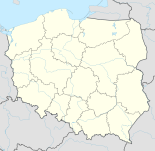Skaliszkiejmy
| Skaliszkiejmy | ||
|---|---|---|

|
|
|
| Basic data | ||
| State : | Poland | |
| Voivodeship : | Warmia-Masuria | |
| Powiat : | Gołdap | |
| Gmina : | Banie Mazurskie | |
| Geographic location : | 54 ° 18 ' N , 22 ° 7' E | |
| Residents : | 30 (2006) | |
| Telephone code : | (+48) 87 | |
| License plate : | NGO | |
| Economy and Transport | ||
| Street : | Obszarniki ↔ Maciejowa Wola - Klewiny | |
| Rail route : | no rail connection | |
| Next international airport : | Danzig | |
Skaliszkiejmy ( German Skallischkehmen , 1938 to 1945 Großsteinau ) is a village in the Polish Warmian-Masurian Voivodeship and belongs to the rural community of Banie Mazurskie (Benkheim) in the powiat Gołdapski ( Goldap district ).
Geographical location
Skaliszkiejmy is located in the northeast of the Warmian-Masurian Voivodeship , 12 kilometers west of the district town Gołdap (Goldap) and 14 kilometers south of the former district capital Darkehmen (1938 to 1946 Angerapp, Russian Osjorsk ), which is now on Russian territory .
history
The 1555 Stalkeimen to 1565 Schaldkeim , 1590 Skollischen after 1596 Schkalischkemey after 1603 Skallischkem and until 1938 Skallischkehmen called small village existed before 1945 from several small farms and homesteads. On May 6, 1874 was in the newly built office district Abschermeningken ( Polish Obszarniki ) integrated, the - 1933 renamed "District Almental" - the circle Darkehmen in Administrative district Gumbinnen the Prussian province of East Prussia belonged.
On January 24, 1934, the then rural community Skallischkehmen was reclassified from the Almental district to the Rogahlen district (in Polish: Rogale ). This was called from 1939 "Gahlen district" and also belonged to the Darkehmen district , which was then renamed in 1939 to "Angerapp district".
Skallischkehmen recorded 145 inhabitants in 1910. Their number rose to 165 by 1925, amounted to 148 in 1933 and was still 127 in 1939. On June 3 - officially confirmed on July 16 - of the year 1938, Skallischkehmen received the for political and ideological reasons Avoidance of foreign-sounding place names, renaming to "Großsteinau".
As a result of the war, the place came to Poland in 1945 along with the whole of southern East Prussia and has since borne the Polish name form "Skaliszkiejmy". Today the place is the seat of a Schulzenamt ( Polish Sołectwo ) and a place in the network of the rural community Banie Mazurskie in the powiat Gołdapski , before 1998 the Suwałki Voivodeship , since then the Warmia-Masurian Voivodeship belongs.
church
Before 1945 Skallischkehmen resp. Großsteinau of the Evangelical Church in Kleszowen (1936 to 1938 Kleschowen, 1938 to 1946 Kleschauen, Russian Kutusowo ) in the church district Darkehmen / Angerapp in the church province of East Prussia of the Church of the Old Prussian Union or in the Catholic parish Goldap ( Polish Gołdap ) in the deanery Masuria II ( Seat: Johannisburg , Polish Pisz) parish in the Diocese of Warmia .
Today Skaliszkiejmy belongs to the Catholic parish Żabin (Klein Szabienen / Schabienen , 1938 to 1945 Kleinlautersee) within the Gołdap Dean's Office in the Diocese of Ełk (Lyck) of the Roman Catholic Church in Poland . The Protestant church members are based on Gołdap , the branch church of Suwałki in the Masuria diocese of the Evangelical-Augsburg Church in Poland .
traffic
Skaliszkiejmy is a little away from the traffic on a not very important side road, the one from Obszarniki (Abschermeningken , 1938 to 1945 Almental) - located directly on the Polish-Russian state border - via Maciejowa Wola (Matzwolla , 1938 to 1945 Balschdorf) to Klewiny (Klewienen , 1938 to 1945 Tannenwinkel) leads. There is no rail link.
Individual evidence
- ↑ Dietrich Lange, Geographical Register of Places East Prussia (20059: Großsteinau)
- ^ Rolf Jehke, district of Abschermeningken / Almental
- ^ Rolf Jehke, District of Rogahlen / Gahlen
- ^ Uli Schubert, municipality directory, district Darkehmen
- ^ Michael Rademacher: German administrative history from the unification of the empire in 1871 to the reunification in 1990. Darkehmen district. (Online material for the dissertation, Osnabrück 2006).
- ^ Walther Hubatsch , History of the Protestant Church in East Prussia , Volume 3: Documents , Göttingen, 1968, p. 478
